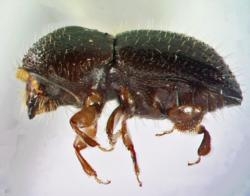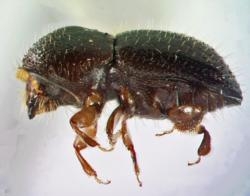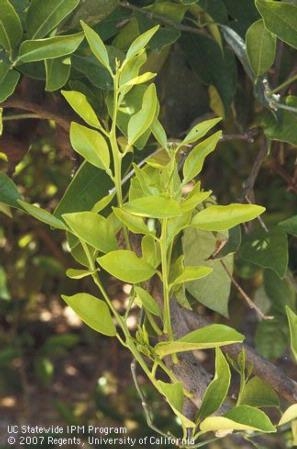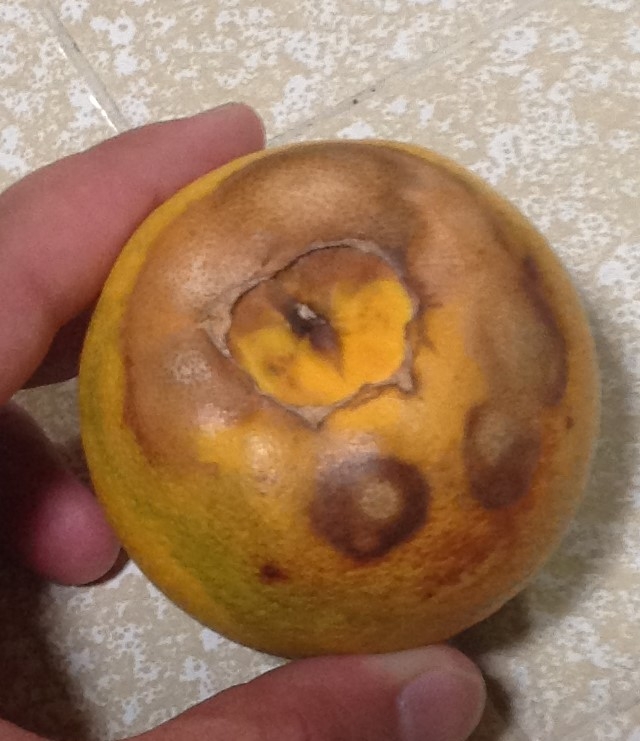- Author: Ben Faber
At a recent conference in Florida, University of Florida entomologist Daniel Carrillo reported some very disturbing news. There is a fungus/pest complex in Florida avocado and related native laurel species that is similar to a complex found in the California - Shot Hole Borer/Fusarium fungus complex. There it is called Laurel Wilt Disease and is a complex of the ambrosia beetle Xyleborus and the fungus Rafaelea lauricola. It is a fungus/insect complex that causes death in avocado and the relatives of avocado trees. The California complex can cause the death of many tree species, such as sycamore, coast live oak and willow, as well as the decline of avocado. The complex and disease are called Fusarium Dieback here, caused by Euwallacea ambrosia beetle and Fusarium fungus.
What Carrillo and other colleagues have found is that there are similar species to their introduced Rafaelea species of ambrosia beetle that are now attacking live avocado trees. These so-called cryptic species are members of a group of beetles that normally do not attack live trees. These beetles are typically some of the first group of decomposers that go after dead trees. These newly identified insects are morphologically very similar to the original beetle, but are native members of the Florida environment. They too are now attacking live trees. There are now ten potential species of ambrosia beetle that can introduce pathogenic fungi.
To exacerbate the situation, there are other fungi now that have been associated with these beetles that may be similarly as pathogenic as the original fungus. These fungi are genetically distinct from the species causing damage in California. However, this ability of different fungi to adapt to a new invasive beetle species and the ability of other beetle species to pick up the pathogenic fungal species is a scenario that might appear in California.
As the world becomes smaller and more living materials are moved around and they mix, this may be the new reality we are facing.
To read more about the Florida findings check out the article:
http://www.mdpi.com/2075-4450/7/4/55
http://ucanr.edu/sites/socaloakpests/Polyphagous_Shot_Hole_Borer/

- Author: Ben Faber
There's a lot of work being done in Florida on a pest/disease complex like we have here with Shot Hole Borer and Fusarium fungus – Fusarium Dieback. This hits avocados and a lot of other native trees like sycamore, willow and coast live oak. Some of the success in Florida may be applicable and we are working with their researchers there to adapt some of the techniques here.
Redbay ambrosia beetle, Xyleborus glabratus, is a wood-boring pest that has now invaded nine states in the southeastern United States. The beetle's dominant fungal symbiont (Raffaelea lauricola) is phytopathogenic, inducing laurel wilt in trees within the family Lauraceae. Members of the genus Persea are particularly susceptible to the lethal disease, including native redbay (P. borbonia) and swampbay (P. palustris), as well as commercial avocado. Cubeb oil lures are the current standard for detection of X. glabratus, but recently eucalyptol and a 50% α-copaene oil have been identified as additional attractants. This study used a combination of choice bioassays, field cage release-and-recapture assays, and a 12-week field trial to compare efficacy of eucalyptol and copaene lures relative to commercial cubeb lures. In addition, gas chromatography (analyzer for volatiles) was used to quantify emissions from lures field-aged for 12 wk. In field cage assays, copaene lures recaptured a higher percentage of released beetles than cubeb lures. In the field test, cubeb lures captured fewer beetles than copaene lures, and lowest captures were obtained with eucalyptol lures. Both copaene and cubeb lures were effective in attracting X. glabratus for 12 weeks, but field life of eucalyptol lures was only 4 weeks, consistent with the quantification of lure emissions. Results suggest that the 50% α-copaene lure provides the best pest detection currently available for X. glabratus.
So why is this important? For one, it will serve as a tool for more effectively monitoring the presents of the beetle. But more importantly, it might be used as a lure to attract them away from trees. Fool them into going somewhere else, like to die.

- Author: Richard Stouthamer
The recent find of the Kuroshio shot-hole borer in Santa Barbara shows that the beetle is expanding up the coast and it comes on top of the finding earlier this year of a single Kuroshio shot-hole borer in San Luis Obispo. Earlier yet in 2014 a single beetle identified as Euwallacea fornicatus was found by the CDFA monitoring in Santa Cruz county, unfortunately this specimen was only identified using morphological characters and therefore we do not know which of the three cryptic species of the Euwallacea fornicatus species complex we are dealing with for that particular find. After the single find (2016) in San Luis Obispo a several additional traps were placed in the vicinity of the first find but no additional beetles have been caught. In a single location in Irvine KSHB has also been detected last year (2015). Recently, the Kuroshio Shot-hole borer has also been reported in Tijuana Mexico, which is not surprising since the heavily infested Tijuana river valley park in San Diego county is less than 0.6 miles from the border with Tijuana. It is clear from these detections that the KSHB is on the move, just like the PSHB. These long distance moves by the beetles are most likely caused by human transport, and the most likely culprit is wood transported after trees have been cut down or trimmed. Both in San Luis Obispo and the location in Santa Cruz no additional finds have been reported, often the density of insects following an invasion of a new area remains low while the population is expanding and followed by it reaching such levels that they are “suddenly” detected in many locations.

- Author: Ben Faber
I used to think that you could not add enough mulch into an orchard and cause any harm. Well, I've been proved wrong a number of times. Some people have gone overboard and put on three to five feet for some reason and it causes all manner of problems, the least of which is usually just getting around in the orchard. But organic matter is the energy source that drives a lot of positive good in an orchard. It provides nutrients for the plants, as well as the microbes that protect plant health, keeps weeds down and maintains an even soil moisture content.
In agriculture, mulch has been viewed as an important input to maintain good tree health, especially in avocado orchards. That has been true up until the introduction of Asian Citrus Psyllid (ACP) and Polyphagous Shot Hole Borer (PSHB, and a close relative Kuroshio Shot Hole Borer ((KSHB))) into California. These are insects that carry disease that are lethal to trees. The ACP can carry a bacteria that causes the death of citrus trees. It has been a major cause of tree death in Florida, as well as other parts of the world. It is severely threatening the industry in that State as it does in California. It also threatens all backyard citrus wherever they are found. PSHB, on the other hand, is another insect that carries a fungal disease that threatens not just one species of tree, such as avocado, but many native trees, such as coast live oak, sycamore, willow and many other native tree species.
Initially these pests were pretty much confined to the Los Angeles Basin and south, but ACP has moved into the Central Valley, and through Ventura up the coast. Its progress has been monitored by traps. PSHB has been found in parts of Ventura County, but it is not widespread, as far as we know at this point. Both insects can be easily moved by contaminated plant material. ACP can be found in infested leaves and on fruit. Moving that material increases the likelihood of spread. PSHB can be moved in wood where it makes its galleries. Moving wood and chips, can spread this pest/disease complex.
The way to help control the spread of these two pest and their disease causing organisms is to stop the spread of materials. This means don't move material from known infested areas, such as the LA Basin into Ventura. It means know where your mulch is sourced. Ideally, if you mulch, it should be with material found onsite. Chip the trees on your property and use it there. This is a threat not only to you, but your neighbors, as well. Be a good neighbor.
For more on ACP and PSHB/KSHB see:
http://eskalenlab.ucr.edu/avocado.html
http://eskalenlab.ucr.edu/distribution.html
http://eskalenlab.ucr.edu/handouts.html
http://ucanr.edu/sites/KACCitrusEntomology/Training_Materials/Educational_Materials/
Photos: ACP and PSHB


- Author: Ben Faber
Drought Induced Problems in Our Orchards
Abiotic disorders are plant problems that are non-infective. They are not caused by an organism, but through their damage, they may bring on damage caused by organisms. Think of a tree hit by lightning or a tractor. The damage breaches the protective bark which allows fungi to start working on the damaged area, eventually leading to a decayed trunk. It was the mechanical damage, though that set the process in motion.
Too much or too little water can also predispose a plant to disease. Think of Phytophthora root rot or even asphyxiation that can come from waterlogging or too frequent irrigations.
Salinity Effects from Lack of Water
Lack of water and especially sufficient rainfall can lead to salinity and specific salts like boron, sodium and chloride accumulating in the root zone. This happens from a lack of leaching that removes native soil salts from the root zone or the salts from the previous salt-laden irrigation from the root zone. These salts cause their own kind of damage, but they can also predispose a tree to disorders, disease and invertebrate (insect and mite) damage.
Lack of water and salt accumulation act in a similar fashion. Soil salt acts in competition with roots for water. The more soil salt, the harder a tree needs to pull on water to get what it needs. The first symptom of lack of water or salt accumulation may be an initial dropping of the leaves. If this condition is more persistent, though we start to see what is called “tip burn” or “salt damage”. Southern California is tremendously dependent on rainfall to clean up irrigation salts, and when rain is lacking, irrigation must be relied on to do the leaching
As the lack of leaching advances (lack of rainfall and sufficient irrigation leaching) the canopy thins from leaf drop, exposing fruit to sunburn and fruit shriveling.
Leaf drop and fruit shriveling in avocado.
In the case of sensitive citrus varieties like mandarins, water stress can lead to a pithy core with darker colored seeds, almost as if the fruit had matured too long on the tree.
Total salinity plays an important factor in plant disorder, but also the specific salts. These salts accumulate in the older leaves, and cause characteristic symptoms that are characteristic in most trees. Boron will appear on older leaves, causing an initial terminal yellowing in the leaf that gradually turns to a tip burn.
Often times it is hard to distinguish between chloride, sodium and total salinity damage. It is somewhat a moot point, since the method to control all of them is the same – increased leaching. There is no amendment or fertilizer that can be applied that will correct this problem. The damage symptoms do not go away until the leaf drops and a new one replaces it. By that time hopefully rain and/or a more efficient irrigation program has been put in place.
The Impact of Drought on Nutrient Deficiencies
Salinity and drought stress can also lead to mineral deficiencies. This is either due to the lack of water movement carrying nutrients or to direct completion for nutrients. A common deficiency for drought stressed plants is nitrogen deficiency from lack of water entraining that nutrient into the plant.
This usually starts out in the older tissue and gradually spreads to the younger tissue in more advanced cases.
The salts in the root zone can also lead to competition for uptake of other nutrients like calcium and potassium. Apples and tomatoes are famous for blossom end rot when calcium uptake is low, but we have also seen it in citrus. Low calcium in avocado, and many other fruits, leads to lower shelf life. Sodium and boron accumulation in the root zone can lead to induced calcium deficiencies and increased sodium can also further lead to potassium deficiencies. Leaching can help remove these competitive elements.
Drought Effect on Tree Disease
Drought and salt stress can also lead to disease, but in many cases once the problem has been dealt with the disease symptoms slowly disappear. They are secondary pathogens and unless it is a young tree (under three years of age) or one blighted with a more aggressive disease, the disease condition is not fatal. Often times, in the best of years, on hilly ground these diseases might be seen where water pressure is lowest or there are broken or clogged emitters. The symptoms are many – leaf blights, cankers, dieback, gummosis – but they are all caused by decomposing fungi that are found in the decaying material found in orchards, especially in the naturally occurring avocado mulch or artificially mulched orchards. Many of these fungi are related Botryosphaerias, but we once lumped then all under the fungus Dothiorella. These decay fungi will go to all manner of plant species, from citrus to roses to Brazilian pepper.
Another secondary pathogen that clears up as soon as the stress is relieved is bacterial canker in avocado. These ugly cankers form white crusted circles that ooze sap, but when the tree is healthy again, the cankers dry up with a little bark flap where the canker had been.
Drought Effect on Pests
Water/salt stress also makes trees more susceptible to insect and mite attack. Mites are often predated by predacious mites, and when there are dusty situations, they can't do their jobs efficiently and mites can get out of hand. Mite damage on leaves is often noted in well irrigated orchards along dusty picking rows
Many borers are attracted to water stressed trees and it is possible that the Polyphagous and Kuroshio Shot Hole Borers are more attracted to those trees.
And then we have conditions like Valencia rind stain that also appears in other citrus varieties. We know it will show up in water stressed trees, but we aren't sure what the mechanism that causes this rind breakdown just at color break. Could it be from thrips attracted to the stressed tree or a nutrient imbalance, it's not clear?
Water and salt stress can have all manner of effects on tree growth. It should lead to smaller trees, smaller crops and smaller fruit. The only way to manage this condition is through irrigation management. Using all the tools available, such as CIMIS, soil probes, soil sensors, your eyes, etc. and good quality available water are the way to improve management of the orchard to avoid these problems.
Scroll down for Images
Tip Burn, notice sun burn bottom right hand fruit
Endoxerosis with dried out core
Boron toxicity
Nitrogen deficiency
Blossom end rot
Potassium deficiency
Bot gumming in lemon
Black Streak in Avocado
Bacterial Canker
Citrus red mite
Polyphagous Shot Hole Borer damage on avocado
Valencia Rind Stain














